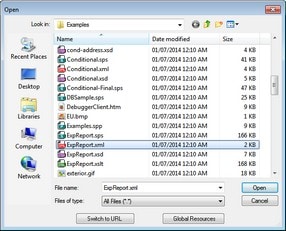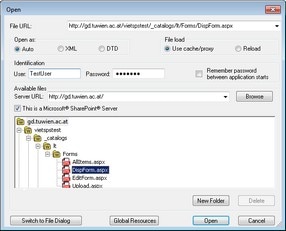DTDs and XML Schemas
An SPS can be based on an XML Schema or DTD or have one or more XML Schemas or DTDs among its schema sources. An XML Schema or DTD can be created as a schema source in one of the following ways:
•The XML Schema or DTD is is created as a schema source directly when the SPS is created (File | New | New from XML Schema / DTD / XML).
•The XML Schema or DTD is added to an empty SPS or to an SPS with existing schema sources (in the Design Overview sidebar).
The respective commands prompt you to browse for the XML Schema or DTD. If the schema is valid, it is created as a schema source in the Schema Sources tree of the Schema Tree sidebar. Alternatively, an XML file can be selected. If an XML Schema (.xsd) or DTD file is associated with the XML file, then the XML Schema or DTD file is loaded as the source schema and the XML file is loaded as the Working XML File. If no schema is associated with the XML file, a dialog pops up asking whether you wish to generate an XML Schema based on the structure and contents of the XML file or browse for an existing schema. If you choose to generate a schema, the generated schema will be loaded as the source schema, and the XML file will be loaded as the Working XML File.
In several File Open and File Save dialogs, you can choose to select the required file or save a file via a URL or a global resource (see screenshot below). Click Switch to URL or Global Resource to go to one of these selection processes.
Selecting files via URLsTo select a file via a URL (either for opening or saving), do the following:
1.Click the Switch to URL command. This switches to the URL mode of the Open or Save dialog (the screenshot below shows the Open dialog). 2.Enter the URL you want to access in the Server URL field (screenshot above). If the server is a Microsoft® SharePoint® Server, check the Microsoft® SharePoint® Server check box. See the Microsoft® SharePoint® Server Notes below for further information about working with files on this type of server. 3.If the server is password protected, enter your User-ID and password in the User and Password fields. 4.Click Browse to view and navigate the directory structure of the server. 5.In the folder tree, browse for the file you want to load and click it. The file URL appears in the File URL field (see screenshot above). The Open or Save button only becomes active at this point. 6.Click Open to load the file or Save to save it.
Note the following:
•The Browse function is only available on servers which support WebDAV and on Microsoft SharePoint Servers. The supported protocols are FTP, HTTP, and HTTPS. •To give you more control over the loading process when opening a file, you can choose to load the file through the local cache or a proxy server (which considerably speeds up the process if the file has been loaded before). Alternatively, you may want to reload the file if you are working, say, with an electronic publishing or database system; select the Reload option in this case. .
|
Note the following points about files on Microsoft® SharePoint® Servers:
•In the directory structure that appears in the Available Files pane (screenshot below), file icons have symbols that indicate the check-in/check-out status of files. Right-clicking a file pops up a context menu containing commands available for that file (screenshot above).
•The various file icons are shown below:
•After you check out a file, you can edit it in your Altova application and save it using File | Save (Ctrl+S). •You can check-in the edited file via the context menu in the Open URL dialog (see screenshot above), or via the context menu that pops up when you right-click the file tab in the Main Window of your application (screenshot below).  •When a file is checked out by another user, it is not available for check out. •When a file is checked out locally by you, you can undo the check-out with the Undo Check-Out command in the context menu. This has the effect of returning the file unchanged to the server. •If you check out a file in one Altova application, you cannot check it out in another Altova application. The file is considered to be already checked out to you. The available commands at this point in any Altova application supporting Microsoft® SharePoint® Server will be: Check In and Undo Check Out.
|
To open or save a file via a global resources, click Global Resource. This pops up a dialog in which you can select the global resource. These dialogs are described in the section, Using Global Resources. For a general description of Global Resources, see the Global Resources section in this documentation. |
The anyType datatype of XML Schema
If an element in the XML Schema has been assigned the anyType datatype of XML Schema or if it has not been assigned any datatype, then the schema tree in the Schema Tree will show this element as having all the global elements of that schema as possible children. For example, if an element called email has not been assigned any datatype, then it will be displayed in the schema tree with all global elements as possible children, such as, for example: person, address, city, tel, etc. To avoid this, assign the email element a datatype such as xs:string.







